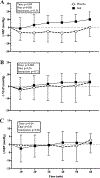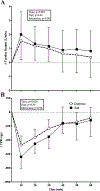Salt Loading Blunts Central and Peripheral Postexercise Hypotension
- PMID: 31609296
- PMCID: PMC7144834
- DOI: 10.1249/MSS.0000000000002187
Salt Loading Blunts Central and Peripheral Postexercise Hypotension
Abstract
Introduction: High salt intake is a widespread cardiovascular risk factor with systemic effects. These effects include an expansion of plasma volume, which may interfere with postexercise hypotension (PEH). However, the effects of high salt intake on central and peripheral indices of PEH remain unknown. We tested the hypothesis that high salt intake would attenuate central and peripheral PEH.
Methods: Nineteen healthy adults (7 female/12 male; age, 25 ± 4 yr; body mass index, 23.3 ± 2.2 kg·m; V[Combining Dot Above]O2peak, 41.6 ± 8.7 mL·min·kg; systolic blood pressure (BP), 112 ± 9 mm Hg; diastolic BP, 65 ± 9 mm Hg) participated in this double-blind, randomized, placebo-controlled crossover study. Participants were asked to maintain a 2300 mg·d sodium diet for 10 d on two occasions separated by ≥2 wk. Total salt intake was manipulated via ingestion of capsules containing either table salt (3900 mg·d) or placebo (dextrose) during each diet. On the 10th day, participants completed 50 min of cycling at 60% V[Combining Dot Above]O2peak. A subset of participants (n = 8) completed 60 min of seated rest (sham trial). Beat-to-beat BP was measured in-laboratory for 60 min after exercise via finger photoplethysmography. Brachial and central BPs were measured for 24 h after exercise via ambulatory BP monitor.
Results: Ten days of high salt intake increased urinary sodium excretion (134 ± 70 (dextrose) vs 284 ± 74 mmol per 24 h (salt), P < 0.001), expanded plasma volume (7.2% ± 10.8%), and abolished PEH during in-laboratory BP monitoring (main effect of diet, P < 0.001). Ambulatory systolic BPs were higher for 12 h after exercise during the salt and sham trials compared with the dextrose trial (average change, 3.6 ± 2.1 mm Hg (dextrose), 9.9 ± 1.4 mm Hg (salt), 9.8 ± 2.5 mm Hg (sham); P = 0.01). Ambulatory central systolic BP was also higher during the salt trial compared with dextrose trial.
Conclusion: High salt intake attenuates peripheral and central PEH, potentially reducing the beneficial cardiovascular effects of acute aerobic exercise.
Figures




References
-
- Mancia G, De Backer G, Dominiczak A et al. 2007 Guidelines for the Management of Arterial Hypertension. Journal of Hypertension. 2007;25:1105–87. - PubMed
-
- Dimeo F, Pagonas N, Seibert F, Arndt R, Zidek W, Westhoff TH. Aerobic exercise reduces blood pressure in resistant hypertension. Hypertension. 2012;60:653–8. - PubMed
-
- Whelton PK, Carey RM, Aronow WS et al. 2017. ACC/AHA/AAPA/ABC/ACPM/AGS/APhA/ASH/ASPC/NMA/PCNA Guideline for the Prevention, Detection, Evaluation, and Management of High Blood Pressure in Adults. Journal of the American College of Cardiology. 2017:735–1097. - PubMed
-
- Muntner P, Carey RM, Gidding S et al. Potential U.S. Population Impact of the 2017 American College of Cardiology/American Heart Association High Blood Pressure Guideline. Journal of the American College of Cardiology. 2017;71(2):109–18. - PubMed
-
- Thompson PD, Crouse SF, Goodpaster B, Kelley D, Moyna NM, Pescatello LS. The acute versus the chronic response to exercise. Med Sci Sports Exerc. 2001;33:S438–45; discussion S52–3. - PubMed
Publication types
MeSH terms
Substances
Grants and funding
LinkOut - more resources
Full Text Sources
Medical

